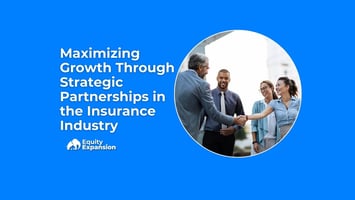Running an insurance agency presents a unique set of challenges. You’re not just tasked with...
Is Selling the Only Way to Grow Or Can the Right Partner Help You Stay in the Game?
 Is Selling the Only Way to Grow Or Can the Right Partner Help You Stay in the Game?
Is Selling the Only Way to Grow Or Can the Right Partner Help You Stay in the Game?
In a town just outside of Harrisburg, Pennsylvania, one insurance agency owner found himself at a crossroads looking to simplify operations, keep his long-time team intact, and continue working without sacrificing growth. With over $250,000 in annual commissions, a loyal client base, and a clean loss ratio (30% personal lines), his business was stable but stuck.
He didn’t want to retire yet. He didn’t want to manage staff anymore. And he didn’t want to lose clients due to lack of carrier access. So, he started exploring partnerships. What followed were two very different conversations with two potential buyers. Both offered value but through very different lenses.
Buyer A: Scale Through Systems
Buyer A brought a compelling track record: $0 to $25 million in revenue, writing in all 50 states, and over 450 carriers under management. Their pitch was straightforward: take 19 hats off your head so you can wear just one producer.
They emphasized:
- Operational Relief: Handling payroll, hiring, service, accounting, and IT through a centralized back office.
- Client Retention Support: With rising home and auto premiums, their team helps proactively re-market policies to avoid client churn.
- Strategic Growth: A model called the “Agency Success Framework” that enables existing agencies to scale without losing their identity.
- Personal Focus: The buyer understood the owner’s desire to spend weekends at his Rehoboth house and acknowledged his family responsibilities, including caring for his aging mother.
Buyer A’s offer focused on systems, service, and freedom with no expectation to leave the business. The owner would keep working, just with fewer burdens.
Buyer B: Ownership With Alignment
Buyer B told a different story. With $80 million in revenue and 400 employees, this firm started as a small family business and scaled through 20 acquisitions. They now operate offices from New Hampshire to Miami but had no footprint in Pennsylvania yet.
Their approach emphasized:
- Shared Ownership: A typical deal structure of 80% cash and 20% equity in the parent company. This gave the owner both liquidity and long-term upside.
- Cultural Fit: The CEO of the firm personally joined the call, offering a direct relationship and promising no “corporate layers” between leadership and local teams.
- Continuity: “If it’s not broken, we don’t fix it.” The office location, team, and workflows could remain intact.
- Commitment to People: The owner’s long-time producer, Vicki, would be taken care of with equal benefits as any other team member.
Buyer B leaned into legacy, respect, and shared value creation. They viewed the agency owner not as a transaction but as a future co-owner.
The Takeaway: What Matters More Systems or Stake?
Both buyers offered compelling benefits, and neither tried to pressure a decision. But the comparison brings a few lessons for agency owners exploring a similar path:
- Annual commissions around $265,000 don’t make you too small to attract strong partners what matters is profitability and potential.
- Low loss ratios and clean books are assets worth leveraging.
- Culture fit matters as much as the check whether you’re aiming to offload tasks or build equity.
- You don’t have to exit to benefit. Both buyers encouraged the owner to stay on, continue producing, and gradually shape their exit on their terms.
.jpg?height=200&name=Blue%20and%20White%20Modern%20Building%20Strategic%20Partnerships%20Presentation%20(2).jpg)

